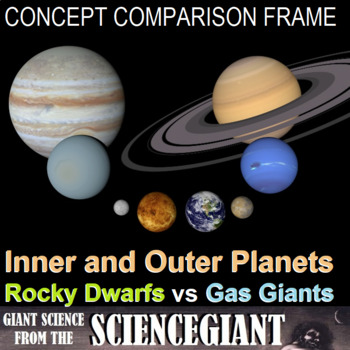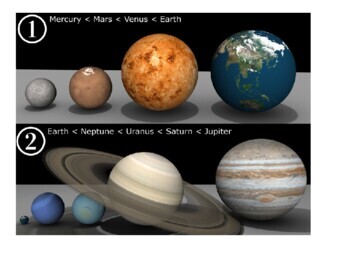Concept Compare: The Inner and Outer Planets (rocky dwarf vs. gas giant)
- Word Document File
Also included in
- Teachers use the Strategic Instruction Model (SIM) Concept Enhancement Routines to transform abstract main ideas and key topics into a concrete representation that helps students think about and talk about the key topic and essential related information. SIM is about promoting effective teaching andPrice $49.70Original Price $71.00Save $21.30
Description
How are the other planets of our solar system different from Earth? This Concept Comparison Frame helps students contrast the Inner and Outer Planets, with the terrestrial rocky dwarfs of Mercury, Venus, Earth and Mars on the one side, and jovian gas giants of Jupiter, Saturn, Uranus, and Neptune on the other.
The Concept Comparison Routine is used help compare and contrast key concepts. Specifically, students use like and unlike characteristics and categories shared and not shared by two or more concepts to better understand the overall concept. Students taught using the Content Enhancement routines earned higher total test scores than did students taught using the lecture-discussion method.
Personally, I use the Content Enhancement Routines to figure out what I want to say and how I want to say it. It keeps my "Sage on the Stage" time limited to what fits onto 2-3 pages (about 45 minutes of directed class discussion). This product includes the completed frame, and the student guide blanked except for vocabulary and graphics already filled in. It is in Microsoft Word .doc form so that Ts can customize the discussion to fit the needs of their Ss.
These Content Enhancement Routines are classroom tested to help students with the following Florida Next Generation Sunshine State Standards in Science.
Students Will Be Able To (SWBAT)
- SC.8.E.5.3 Distinguish the hierarchical relationships between planets and other astronomical bodies relative to solar system, galaxy, and universe, including distance, size, and composition.
- SC.8.E.5.4 Explore the Law of Universal Gravitation by explaining the role that gravity plays in the formation of planets, stars, and solar systems and in determining their motions.
- SC.8.E.5.7 Compare and contrast the properties of objects in the Solar System including the Sun, planets, and moons to those of Earth, such as gravitational force, distance from the Sun, speed, movement, temperature, and atmospheric conditions.
- SC.8.E.5.8 Compare various historical models of the Solar System, including geocentric and heliocentric.
- SC.8.P.8.2 Differentiate between weight and mass recognizing that weight is the amount of gravitational pull on an object and is distinct from, though proportional to, mass.
- SC.912.E.5.2 Identify patterns in the organization and distribution of matter in the universe and the forces that determine them.
- SC.912.E.5.5 Explain the formation of planetary systems based on our knowledge of our Solar System;
- SC.912.E.5.6 Develop logical connections through physical principles, including Kepler's and Newton's Laws about the relationships and the effects of Earth, Moon, and Sun on each other.
- SC.912.L.15.8 Describe the scientific explanations of the origin of life on Earth.
Related Product
- Logic Line-Up Planetary Puzzle on the Solar System
- Concept Comparison: Dwarf Planets Ceres, Pluto, Huamea, Eris, and Makemake
#StayGiant and stay up on my new resources and STEM news. Look for the green ★ star near the top of any page within my store and click "FOLLOW". Stand on The Shoulders of Giants, and together we'll see further, inspire students, and enlighten inquisitive minds!






